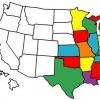While I fly a Piper, I had to chime in on this discussion. I have the exact same question with a different twist. My Cherokee 6-260 has a single combination landing/taxing light in the center of the lower cowling. Even though I have upgraded to a new LED PAR36 lamp with whighter and brighter light, more even distribution and triple the lumens, it is simply not enough considering 20% of my flying is at night.
For me, to gain more light, STC options include wingtip light upgrades for $900 plus shipping and installation ($1000 more for cutting and riviting and fishing wires through impossible cavities), so I spent time just looking for other options. I found a flush mount 500 lumen LED light (totally enclosed, flat backed heat sink) and imagined two of these mounted under the lower cowling to SUPPLEMENT my current landing light. There are obvious benefits: (1) Chance of three lights failing highly unlikely, (2) double current lighting, (3) lens options include narrow beams and wide for the same lights, allowing for landing or taxi configuration or both utilizing two lamps, (4) small size fits about anywhere, (5) weight is minimal, (6) lamps operate in 10-32VDC range, (7) my mount can be shimmed and aimed in ANY direction, including downward by 15 degrees to allow for illuminating what you are landing on while your nose is up on short final...
Here's the twist: I will not modify the aircraft in any way, no holes, no fiberglass work, no mess. My concept is this: Using a custom aluminum plate that I am fabricating at a local metal shop, I will bolt two of these low profile LED lights to the fixed upper portion (mounted to engine mount) of my landing gear strut (just under lower cowling.) Using off the shelf stainless steel clamps and approved fasteners, this fixture will be smaller and narrower than the landing lights on any nose gears that contain standard lamps. Total weight will less than 2 pounds and wiring will simply run up into lower cowling and splice into existing power connector for landing light circuit (3 lamps in parallel). Total current draw for all three LED lights combined will be less than the 50W GE H7604 I used to use, which is half of the wattage allowed for the circuit (100W). I figure tripling the amount of light, tripling the number of lamps and adding to safety of the aircraft operation (not to mention seeing the numbers and the ramp at night) is an overall win, considering it will take me all of 30 minutes to install this once my prototype plate is fabricated this week.
All the research I have done is that my concept would be considered minor by any stretch since no modification of the airframe is involved. The fixture is under the aircraft and just aft of the propeller wash, so I believe aerodynamics are minute, if any. Considering it will be a minor alteration, I expect after flight testing that a log book entry will be all that is required. If I ever cross paths with anyone that disagrees, it can be removed in 5 minutes by loosening four 3/8-16 nylon locknuts and disconnecting a single molex connector (power).
Any thoughts?

